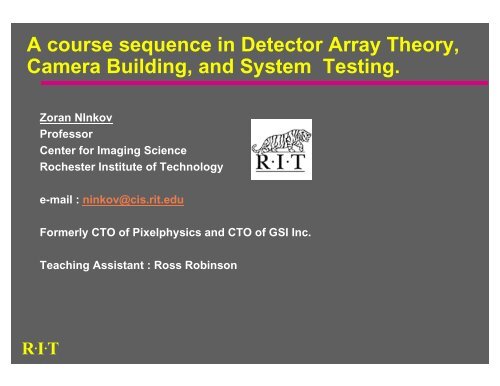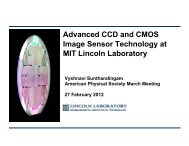A course in CCD camera building - Better Physics
A course in CCD camera building - Better Physics
A course in CCD camera building - Better Physics
- No tags were found...
You also want an ePaper? Increase the reach of your titles
YUMPU automatically turns print PDFs into web optimized ePapers that Google loves.
A <strong>course</strong> sequence <strong>in</strong> Detector Array Theory,<br />
Camera Build<strong>in</strong>g, and System Test<strong>in</strong>g.<br />
Zoran NInkov<br />
Professor<br />
Center for Imag<strong>in</strong>g Science<br />
Rochester Institute of Technology<br />
e-mail : n<strong>in</strong>kov@cis.rit.edu<br />
Formerly CTO of Pixelphysics and CTO of GSI Inc.<br />
Teach<strong>in</strong>g Assistant : Ross Rob<strong>in</strong>son<br />
R . I . T
Center for Imag<strong>in</strong>g Science<br />
An <strong>in</strong>terdiscipl<strong>in</strong>ary University Research and Education Center,<br />
dedicated to push<strong>in</strong>g the frontiers of imag<strong>in</strong>g <strong>in</strong> all its forms and<br />
uses. The Center has existed s<strong>in</strong>ce 1985 and offers BS, MS, and<br />
PhD degrees.<br />
R . I . T
Research Areas<br />
Algorithms<br />
Medical Imag<strong>in</strong>g<br />
Color Science<br />
Nanoimag<strong>in</strong>g<br />
Materials<br />
Pr<strong>in</strong>ters & Displays<br />
Remote Sens<strong>in</strong>g<br />
Sensors and Imag<strong>in</strong>g Systems<br />
R . I . T
Center for Detectors (Don Figer,<br />
Director)<br />
R . I . T<br />
‐ The Center for Detectors enables<br />
— scientific discovery<br />
— national security<br />
— better liv<strong>in</strong>g<br />
— commercial <strong>in</strong>novation<br />
‐ CfD designs and develops advanced<br />
photon detectors & technology<br />
‐ CfD collaborates with students, scientists, eng<strong>in</strong>eers, and<br />
bus<strong>in</strong>ess partners, at academic, <strong>in</strong>dustrial, and national<br />
research <strong>in</strong>stitutions.<br />
‐ Founded <strong>in</strong> 2006<br />
‐ NSF funded series of talks streamed on‐l<strong>in</strong>e at<br />
http://ridl.cis.rit.edu/ under DVW (Detector Virtual<br />
Workshop).
Three <strong>course</strong> “Detectors”<br />
sequence<br />
- background theory (class 1)<br />
— Pr<strong>in</strong>ciples of Solid State Imag<strong>in</strong>g Arrays (SIMG 739)<br />
— Fall<br />
- build<strong>in</strong>g a <strong>camera</strong> (class 2)<br />
— Fabrication of a <strong>CCD</strong> <strong>camera</strong> (SIMG 528/728)<br />
— W<strong>in</strong>ter<br />
- test<strong>in</strong>g a <strong>camera</strong> (class 3)<br />
— Test<strong>in</strong>g of a <strong>CCD</strong> Camera (SIMG 742)<br />
— Spr<strong>in</strong>g<br />
R . I . T
Rational for the sequence :<br />
“To learn one detector system well”<br />
- detectors are very often the “tall pole” <strong>in</strong> high<br />
performance optical sens<strong>in</strong>g systems. Our<br />
students frequently become the systems<br />
<strong>in</strong>tegrators for such systems.<br />
- <strong>in</strong>dustry and government labs need people<br />
who have this background.<br />
- graduate students can start on <strong>in</strong>strumentation<br />
projects sooner with such preparation<br />
R . I . T
Class 1 : Pr<strong>in</strong>ciples of Solid State<br />
Imag<strong>in</strong>g Arrays (SIMG 739)<br />
- The class meets for 4 lecture hours per week<br />
for the duration of the Fall quarter (i.e.<br />
September through November for 10 weeks).<br />
- The presentation format is two lectures a week<br />
with each lecture of two hours duration.<br />
- Problems sessions once a week.<br />
R . I . T
Selected topics covered <strong>in</strong> class 1<br />
- energy levels, band gap, diffusion theory, and carrier<br />
lifetimes.<br />
- Field Effect Transistors (FET), JFET & MOSFET<br />
construction, sources of MOSFET noise, and use of FETs<br />
<strong>in</strong> a source follower circuit.<br />
- an overview of filter<strong>in</strong>g theory, and an understand<strong>in</strong>g of<br />
the correlated double sampl<strong>in</strong>g circuit.<br />
- FETs as switches and how to use them to build a<br />
multiplexer.<br />
- comb<strong>in</strong><strong>in</strong>g all of the above knowledge to design,<br />
conceptually, a CMOS imag<strong>in</strong>g array.<br />
- hybridized imag<strong>in</strong>g arrays and some examples of such<br />
devices.<br />
- CMOS image sensors.<br />
R . I . T
Class 2 : Fabrication of a <strong>CCD</strong><br />
<strong>camera</strong> (SIMG 528/728)<br />
- 1.5 hour-a-week formal class<br />
- a 10 hour-a-week laboratory over the ten weeks<br />
of w<strong>in</strong>ter quarter (i.e. December through<br />
February).<br />
R . I . T
Selected topics covered <strong>in</strong> lectures<br />
<strong>in</strong> class 2<br />
The class material covers topics relat<strong>in</strong>g to one particular<br />
type of focal plane array, the Charge Coupled Device<br />
(<strong>CCD</strong>). Selected topics <strong>in</strong>clude ;<br />
- a review of the pr<strong>in</strong>ciple of a MOS capacitor<br />
- means and implementation of charge transfer<br />
- channel stops<br />
- buried channel <strong>CCD</strong><br />
- MPP operation<br />
- Enhanc<strong>in</strong>g <strong>CCD</strong> sensitivity (e.g. back and front<br />
illum<strong>in</strong>ation, phosphor coat<strong>in</strong>g for the UV and X-ray)<br />
- <strong>in</strong>terl<strong>in</strong>e and frame transfer <strong>CCD</strong>s,<br />
- 1-phase 2 phase 2 phase 4 phase operation,<br />
- deep depletion <strong>CCD</strong>s.<br />
R . I . T
Class 2 Lab Camera - Aud<strong>in</strong>e<br />
- students are organized <strong>in</strong> groups of three,<br />
- tasked with assembl<strong>in</strong>g a cooled <strong>CCD</strong> <strong>camera</strong> system.<br />
- f<strong>in</strong>al <strong>camera</strong> is a rectangular box that measurers 80 X 80 mm X 95.25<br />
mm, weight is 654 grams.<br />
- use a Kodak KAF 0402, pixel size of 9 microns square, a format of 768<br />
(H) x 512 (V) pixels<br />
- the <strong>CCD</strong> <strong>camera</strong> also utlizes a shutter from Draco.<br />
- a peltier cooler + fan regulates temperature.<br />
- the <strong>camera</strong> is controlled via a PC parallel port.<br />
- Acquisition software controls the <strong>camera</strong> from the PC. As of this time<br />
we use the PISCO<br />
(http://www.astrosurf.com/aud<strong>in</strong>e/English/<strong>in</strong>dex_en.htm)<br />
R . I . T
Orig<strong>in</strong>al <strong>CCD</strong> Cookbook Camera<br />
R . I . T
Lower Board<br />
R . I . T
Upper board<br />
R . I . T
Assembled Camera<br />
R . I . T
Completed Camera & Chip<br />
R . I . T
Completed Camera<br />
R . I . T
Class 3 : Test<strong>in</strong>g of a <strong>CCD</strong> Camera<br />
(SIMG 742)<br />
- a one hour-a-week class and problem session.<br />
- a 10 hour-a-week laboratory.<br />
- Both portions are presented over the ten<br />
weeks of the Spr<strong>in</strong>g Quarter (March through<br />
May).<br />
R . I . T
Purpose<br />
- Students are asked to conduct a series of<br />
calibration experiments similar to what they<br />
might be asked to do <strong>in</strong> a commercial,<br />
government or academic laboratory.<br />
- Students generally use the <strong>camera</strong> fabricated<br />
<strong>in</strong> the prior quarter to conduct these<br />
fundamental test<strong>in</strong>g experiments.<br />
R . I . T
Experiments for class 3<br />
- Measur<strong>in</strong>g the ga<strong>in</strong> (electrons per digital count<br />
out) us<strong>in</strong>g the photon transfer method.<br />
- Measur<strong>in</strong>g the noise, dark current and l<strong>in</strong>earity.<br />
- Determ<strong>in</strong><strong>in</strong>g the quantum efficiency of the <strong>CCD</strong><br />
us<strong>in</strong>g a traceable NIST photodiode and<br />
spectrometer.<br />
- Determ<strong>in</strong><strong>in</strong>g the modulation transfer efficiency<br />
(MTF) us<strong>in</strong>g a s<strong>in</strong>e target.<br />
- Determ<strong>in</strong><strong>in</strong>g the Charge Transfer Efficiency<br />
us<strong>in</strong>g a Fe-55 X-ray source.<br />
R . I . T
Experimental setup<br />
R . I . T
Two images (60 sec) with X-ray<br />
illum<strong>in</strong>ation<br />
R . I . T
Fe-55 decay generates 5.9 KeV X-ray which<br />
produces 1620 e - s<strong>in</strong>gle pixel event.<br />
R . I . T
Subtracted image of two half an hour dark<br />
exposures. Suspected muon events are<br />
highlighted <strong>in</strong> red elipses.<br />
R . I . T
Dark Current as a function of<br />
Temperature<br />
R . I . T
Quantum Efficiency<br />
R . I . T
Photon Transfer Calibration<br />
R . I . T<br />
Description Value Units<br />
Ga<strong>in</strong> 3.29747 e - /ADU<br />
Read Noise 11.0 ± 0.3 ADU<br />
Read Noise 36.0 ± 1.0 e -<br />
Correlation R 2 0.999937 None<br />
Frame Readout Time 15.9 sec
On an imag<strong>in</strong>g system<br />
R . I . T
Enrollment<br />
- students from the College of Science, the College<br />
of Eng<strong>in</strong>eer<strong>in</strong>g, the College of Information<br />
Technology and the College of Imag<strong>in</strong>g Arts &<br />
Sciences.<br />
- They rarely take a class together<br />
- The students are organized <strong>in</strong>to teams of three.<br />
As they progress <strong>in</strong> build<strong>in</strong>g the <strong>camera</strong>, they f<strong>in</strong>d<br />
that each student’s background is of value.<br />
- The elitist mentality (i.e. that one’s own major is<br />
superior to others) that often results from be<strong>in</strong>g<br />
conf<strong>in</strong>ed <strong>in</strong>to <strong>in</strong>creas<strong>in</strong>gly siloed academic<br />
programs is seen not to be true when build<strong>in</strong>g a<br />
complex <strong>in</strong>strument like a <strong>CCD</strong> <strong>camera</strong> (i.e.<br />
students discover that other majors know th<strong>in</strong>gs that<br />
they haven’t learnt).<br />
R . I . T
Assesment of “Pr<strong>in</strong>ciples of Solid State<br />
Imag<strong>in</strong>g Arrays”<br />
- series of homework problem sets utiliz<strong>in</strong>g<br />
MathCad/Matlab/Mathematica.<br />
- a f<strong>in</strong>al exam<strong>in</strong>ation<br />
- a class presentation of fifteen m<strong>in</strong>utes duration<br />
on a type of focal plane detector array that was<br />
not covered <strong>in</strong> class. Students are expected to<br />
utilize the electronic databases (e.g. INSPEC,<br />
SPIE Digital Library). The key element of their<br />
presentation must be an explanation of the<br />
underly<strong>in</strong>g physics govern<strong>in</strong>g the operation of<br />
the device and a clear illustration (i.e. a figure)<br />
of how the detector works.<br />
R . I . T
Assessment of “Fabrication of a<br />
<strong>CCD</strong> <strong>camera</strong>”<br />
- a midterm exam<br />
- a f<strong>in</strong>al exam<br />
- ma<strong>in</strong>ta<strong>in</strong><strong>in</strong>g an up-to-date group laboratory notebook<br />
- a f<strong>in</strong>al oral exam<br />
- the oral exam is often the first time the students have<br />
had to respond directly to questions about their work.<br />
They are put on the spot and for some the experience is<br />
stressful. However it also gives them a taste of what to<br />
expect after graduation.<br />
R . I . T
Assesment of “Test<strong>in</strong>g of a <strong>CCD</strong><br />
Camera”<br />
- f<strong>in</strong>al exam<br />
- detailed reports and conclusions on each of the<br />
laboratory tests the students complete.<br />
- S<strong>in</strong>ce a commercial <strong>CCD</strong> sensor is used <strong>in</strong> the<br />
<strong>camera</strong> system the performance metrics determ<strong>in</strong>ed<br />
by students as part of their laboratory can be<br />
compared to the specifications listed by the<br />
manufacturer.<br />
R . I . T
Connections to <strong>Physics</strong><br />
R . I . T<br />
- understand<strong>in</strong>g the QE of a detectors (need to know<br />
about reflection, absorption length and diffusion etc).<br />
- noise <strong>in</strong> a detector (photon statistics, FET operation)<br />
- MTF of a detector system (diffraction limit, sampl<strong>in</strong>g<br />
theory)<br />
- radiation <strong>in</strong>teraction with a detector (muon<br />
etc <strong>in</strong>teraction <strong>in</strong> silicon)<br />
- dark current generation and latent images (solid state<br />
physics, materials)<br />
- performance variations with temperature (thermal<br />
physics/cryogenics, material conductivity)
Outcomes<br />
- a sense of personal accomplishment<br />
- an excellent understand<strong>in</strong>g of the operation of<br />
many other <strong>in</strong>struments.<br />
- hands-on, practical <strong>course</strong> desired by<br />
employers.<br />
- “capstone” <strong>course</strong> where the years of<br />
conventional <strong>course</strong>work is <strong>in</strong>tegrated <strong>in</strong>to<br />
someth<strong>in</strong>g mean<strong>in</strong>gful and practical for<br />
students.<br />
R . I . T




